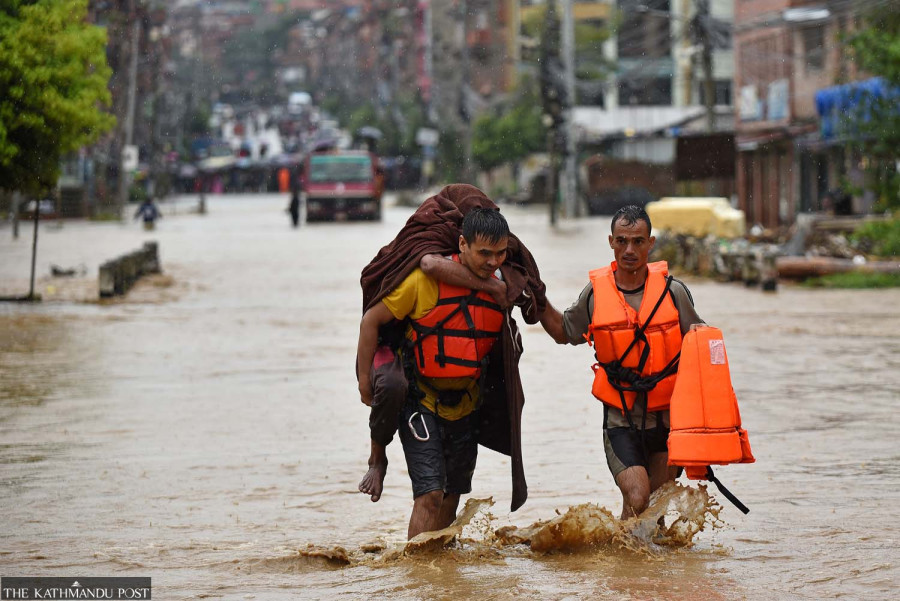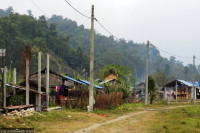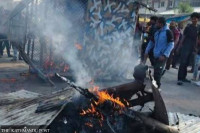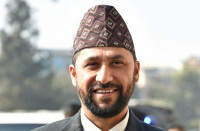National
Government faces criticism over slow rescue as disasters claim lives, property
Floods and landslides after incessant rains have caused widespread destruction across the country, exposing the government’s ineptitude in the face of disasters.
Post Report
The government has again come under sharp criticism over its slow search and rescue operations after intense and relentless rains for the past three days caused widespread loss and destruction across the country.
A least 87 people have been killed and scores have gone missing after the rains triggered floods and landslides around the country. Thousands of travellers have been stranded as all highways linking to the capital Kathmandu are obstructed and roads across the country are badly damaged.
Hundreds of private and public structures have been damaged around the country, while many localities in Kathmandu have been submerged due to massive floods in the Valley’s rivers and attendant water-logging on the streets.
Four people were reportedly swept away by the swollen Nakkhu river in Lalitpur on Saturday morning. They could have been saved had the government been quick to launch a rescue operation, experts say, and this incident has again made people question the state’s seriousness about coming to the help of its citizens in times of crisis.
After failing to escape to a safer place, the four had reportedly climbed to the roof of the hut that they were living in. They requested for a rescue with the local security officials but no help was forthcoming. Ultimately, the river overpowered the hut and swept them away.
Of the four swept away by the Nakkhu, three were rescued by one Chaniklal Tamang from some 300 metres downstream. They were later undergoing treatment at Patan Hospital. According to SSP Shekhar Khanal of Lalitpur, the fourth person remains missing.
People have taken to social media to criticise the government’s apparent apathy for saving the stranded people. But Home Minister Ramesh Lekhak defended the incident saying that they could not be rescued by a chopper due to poor visibility.
Besides holding regular meetings at the home ministry and issuing directives, the government has done little to save the lives of its citizens from disasters, said Nepalis on social media, calling out the government for its poor preparation.
“We tried to rescue them but could not,” said Lekhak while responding to journalists’ queries after a meeting at the ministry. “We are sorry about the unfortunate incident.”
Lekhak added, “Due to poor visibility, no helicopter could conduct the rescue operation… We sent personnel from the Armed Police Force and Nepal Police but they also could not rescue them due to the risk of being swept away by the swollen river.”
Meanwhile, “as many as 21 people have gone missing in the floods in the Capital where army, police and armed police headquarters are located,” former commissioner of the National Human Rights Commission Mohna Ansari wrote on the social media platform X.
This is not the first time the government has been criticised for its sluggish search and rescue operations during natural disasters.
Some social media users have asked Prime Minister KP Sharma Oli to return home to handle the emergency. Oli is currently in the United States to attend the 79th general assembly of the United Nations.
“It is natural to seek guardians at a time when the country is facing a crisis,” Ranju Darshana, the general secretary of Bibeksheel Sajha Party, said. “At this hour of crisis, the prime minister, who is on a US visit, should return and activate his Cabinet.”
Deputy Prime Minister Prakash Man Singh, who is acting prime minister after Oli’s departure for New York, said they are in touch with the prime minister on a regular basis and Oli is taking regular briefings.
The rains have caused heavy damage to the lives and properties in Kathmandu and neighbouring districts. As many as four dozen people have been killed in the Capital alone.
The home ministry said that the government has mobilised over 20,000 security personnel across the country for search and rescue operations. The Nepal Army is also helping rescue people through helicopters and other means.
Political analyst Dambar Khatiwada said the rains have exposed the country’s unplanned habitat and urbanisation. “The looter state and rulers have never given this issue due importance,” he writes on X. “The two-day-long incessant rains have made it clear that our rulers were only busy in making world records in forming and toppling governments and indulging in fraud and corruption.”
Major highways and other roads are obstructed in 68 different places across the country and it will take days to resume the normal operation, said Sushil Babu Dhakal, spokesperson for the Ministry of Physical Infrastructure and Transportation.
The government has several mechanisms from local to provincial to central levels to deal with natural disasters.
There is the National Disaster Risk Reduction and Management Authority and the local governments and other government entities and institutions that work in the sector of disaster management spending millions of rupees from the national coffers, said Rabindra Mishra, senior vice president of Rastriya Prajatantra Party.
“But four people waited for hours near the ministers’ quarters for rescue,” Mishra said. “If the situation in the Capital is so dire, what would it be like outside Kathmandu? Let us learn to stay safe on our own and trust God.”




 11.12°C Kathmandu
11.12°C Kathmandu












%20(1).jpg&w=300&height=200)

